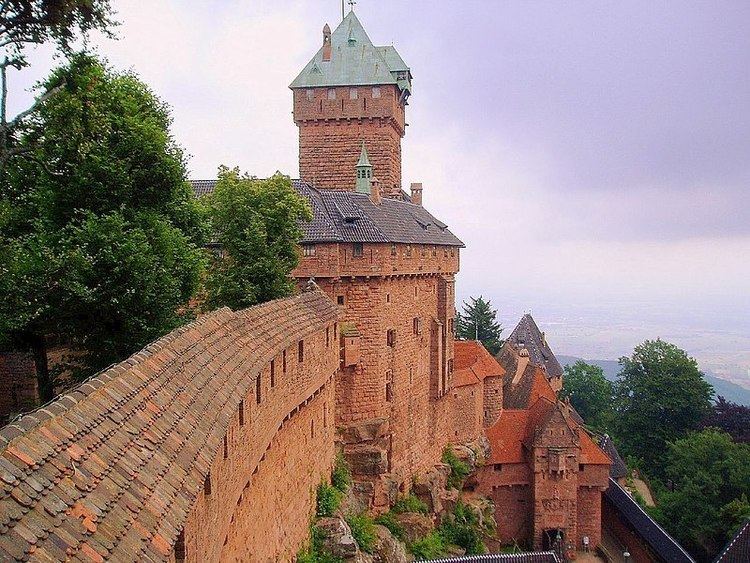Country France GDP (2013) Ranked Area 57,433 km² | Time zone CET (UTC+1) Per capita €27,085 (US$37,312) Prefecture Strasbourg | |
 | ||
Departments 10ArdennesAubeBas-RhinMarneHaute-MarneHaut-RhinMeurthe-et-MoselleMeuseMoselleVosges Total €150.3 billion (US$207.0 bn) Colleges and Universities University of Strasbourg Clubs and Teams FC Metz, AS Nancy Lorraine, Stade de Reims Destinations Strasbourg, Colmar, Reims, Champagne, Nancy Points of interest Jura Mountains, Rhine, Vosges, Château du Haut‑Kœnigsbourg, Zoo d'Amnéville | ||
Grand Est ([ɡʁɑ̃.t‿ɛst]; English: Great East, German: Großer Osten — both in the Alsatian and the Lorraine Franconian dialect), previously Alsace-Champagne-Ardenne-Lorraine (ACAL or less commonly, ALCA), is a French administrative region in northeastern France. It superseded three former administrative regions—Alsace, Champagne-Ardenne, and Lorraine—on 1 January 2016, as a result of territorial reform which was passed by the French legislature in 2014. Alsace-Champagne-Ardenne-Lorraine was a provisional name, created by hyphenating the merged regions in alphabetical order; its regional council had to approve a new name for the region by 1 July 2016. France's Conseil d'État approved Grand Est as the new name of the region on 28 September 2016, effective 30 September 2016. The administrative capital and largest city is Strasbourg.
Contents
- Map of Grand Est France
- Provisional name
- Permanent name
- Geography
- Departments
- Topography
- Hydrology
- Formation
- Opposition
- Demographics
- Regional council
- Rail Transport
- Airports
- Motorways
- Heritage
- References
Map of Grand Est, France
Provisional name
The provisional name of the region was Alsace-Champagne-Ardenne-Lorraine, which is formed by combining the names of the three present regions—Alsace, Champagne-Ardenne, and Lorraine—in alphabetical order with hyphens. The formula for the provisional name of the region was established by the territorial reform law and applied to all but one of the provisional names for new regions. The ACAL regional council, which was elected in December 2015, was given the task of choosing a name for the region and submitting it to the Conseil d'État—France's highest authority for administrative law—by 1 July 2016 for approval. The provisional name of the region was retired on 30 September 2016, when the new name of the region, Grand Est, took effect.
In Alsace and in Lorraine, the new region has frequently been called ALCA, for Alsace-Lorraine-Champagne-Ardennes, on the internet.
Like the name Région Hauts-de-France (and, until 2015, the name Région Centre), the name Région Grand Est contains no reference whatsoever to the area's history or identity, but merely describes its geographical location within metropolitan France.
Permanent name
In a poll conducted in November 2014 by France 3 in Champagne-Ardenne, Grand Est (29.16%) and Austrasie (22.65%) were the top two names among 25 candidates and 4,701 votes. Grand Est also topped a poll the following month conducted by L'Est Republicain, receiving 42% of 3,324 votes.
Among the names which have received a moderate amount of discussion are:
Geography
Grand Est covers 57,433 square kilometres (22,175 sq mi) of land and is the sixth-largest of the regions of France effective 1 January 2016. Grand Est borders four countries—Belgium, Luxembourg, Germany, and Switzerland—along its northern and eastern sides. It is the only French region to border more than two countries. To the west and south, it borders the French regions Nord-Pas-de-Calais-Picardie (provisional name), Île-de-France, and Bourgogne-Franche-Comté (provisional name).
Departments
Grand Est contains ten departments: Ardennes, Aube, Bas-Rhin, Marne, Haute-Marne, Haut-Rhin, Meurthe-et-Moselle, Meuse, Moselle, Vosges.
Topography
The main ranges in the region include the Vosges to the east and the Ardennes to the north.
Hydrology
The region is border on the east by the Rhine which forms most of the border with Germany. Other major rivers which flow through the region include: the Meuse, Moselle, Marne, and Saône.
Lakes in the region include: lac de Gérardmer, lac de Longemer, lac de Retournemer, lac des Corbeaux, Lac de Bouzey, lac de Madine, étang du Stock and lac de Pierre-Percée.
Formation
Grand Est is the result of territorial reform legislation passed in 2014 by the French Parliament to reduce the number of regions in Metropolitan France—the part of France in continental Europe—from 22 to 13. ACAL is the merger of three regions: Alsace, Champagne-Ardenne, and Lorraine.
Opposition
The merger has been strongly opposed in Alsace. The territorial reform law allows new regions to choose the seat of the regional councils, but specifically made Strasbourg the seat of the Grand Est regional council—a move to appease the region's politicians.
Demographics
The region has an official population of 5,554,645 (municipal population on 1 January 2014).
Regional council
The regional council has limited administrative authority, mostly concerning the promotion of the region's economy and financing educational and cultural activities. The regional council has no legislative authority. The seat of the regional council will be Strasbourg. The regional council, elected in December 2015, is controlled by The Republicans. The elected inaugural President of the Grand Est Regional Council is Philippe Richert, who was previously the President of the Alsace Regional Council.
Rail Transport
The region has five tram networks:
Airports
The region has four airports:
Motorways
The region has eighteen motorways:
The region has twelve cities that have ring roads:
Heritage
Grand Est is rich with architectural monuments from the Roman Empire to the early 21st century.
Gothic architecture is particularly conspicuous, with many famous cathedrals, basilicas and churches, such as Reims Cathedral, Strasbourg Cathedral, Metz Cathedral, Troyes Cathedral, Châlons Cathedral, Toul Cathedral, the Basilica of L'Épine, the Basilica of Saint-Nicolas-de-Port, the Basillica of Avioth, the Basilica of St. Urbain in Troyes, Thann Church, Niederhaslach Church, Notre-Dame-en-Vaux, St. George's Church, Sélestat and St. Peter and St. Paul's Church, Wissembourg.
